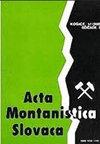应用CFD模型研究确定煤层甲烷爆炸和自燃危险区
IF 1.4
4区 地球科学
Q2 GEOSCIENCES, MULTIDISCIPLINARY
引用次数: 2
摘要
地下采矿作业受到许多自然灾害的影响。由这些危险产生的事件很难预测,如果发生,它们会扰乱整个采矿过程,并对船员构成巨大危险。一些最危险的包括甲烷爆炸和煤炭自燃引起的火灾等通风危害。地下环境的复杂状态意味着这些危险往往同时发生,使采矿条件更加恶劣。以下论文通过开发确定受煤层甲烷爆炸和煤炭自燃危险区域的方法来解决这个问题。之所以提到采空区,是因为这一特定地区最常受到煤炭自燃和危险甲烷积累的影响。所开发的方法基于模型试验,使用CFD方法和开发数值模型所需的数据。这项研究涵盖了一个坚硬煤矿的真实长壁,在开采过程中使用Y系统通风,这在甲烷危险的情况下是有益的,但在煤自燃方面会恶化安全性。根据所进行的研究,对于开采条件,由于甲烷爆炸和煤炭自热的潜在可能性,指定了危险区域。确定危险区域的依据是所检查现象的发生标准。在这项研究中,分别确定了每种调查危害的区域,并确定了它们同时发生的区域。因此,该研究的目的实现了,该研究涉及通过在矿区应用现代建模方法来确定潜在危险区。研究结果是旨在提高研究区域内与研究威胁相关的安全性的活动的非常重要的信息来源。本文章由计算机程序翻译,如有差异,请以英文原文为准。
Applying CFD Model Studies to Determine Zones at Risk of Methane Explosion and Spontaneous Combustion of Coal in Goaves
Underground mining operations are subject to a number of natural hazards. Events resulting from these hazards are difficult to predict, and if they occur, they disrupt the entire mining process and pose a great danger to the crew. Some of the most dangerous include ventilation hazards involving methane explosions and fires caused by the spontaneous combustion of coal. The complex state of the underground environment means that these hazards oftentimes occur simultaneously, making mining conditions even worse. The following paper addresses this issue by developing methodology for determining areas endangered by methane explosions and coal spontaneous combustion in goaves. The reference to goaves results from the fact that this particular area is most frequently affected by coal spontaneous combustion and accumulation of dangerous amounts of methane. The developed methodology was based on model tests with the use of the CFD method and data necessary to develop a numerical model. The research encompassed a real longwall in one of the hard coal mines, ventilated with the Y system during its exploitation, which is beneficial in the case of the methane hazard but worsens the safety in terms of the self-ignition of coal. As a result of the conducted research, for the exploitation conditions, dangerous zones were specified due to a potential possibility of methane explosion and self-heating of coal. The basis for determining dangerous zones were the criteria of occurrence of the examined phenomena. In this study, the zones were identified for each of the investigated hazards separately and for their simultaneous occurrence. Thus, the aim of the study, which involved the determination of potentially hazardous zones by applying modern methods of modelling in the mining area, was achieved. The results are an immensely important source of information for activities aimed at improving safety in the studied area, in relation to the studied threats.
求助全文
通过发布文献求助,成功后即可免费获取论文全文。
去求助
来源期刊

Acta Montanistica Slovaca
地学-地球科学综合
CiteScore
3.60
自引率
12.50%
发文量
60
审稿时长
30 weeks
期刊介绍:
Acta Montanistica Slovaca publishes high quality articles on basic and applied research in the following fields:
geology and geological survey;
mining;
Earth resources;
underground engineering and geotechnics;
mining mechanization, mining transport, deep hole drilling;
ecotechnology and mineralurgy;
process control, automation and applied informatics in raw materials extraction, utilization and processing;
other similar fields.
Acta Montanistica Slovaca is the only scientific journal of this kind in Central, Eastern and South Eastern Europe.
The submitted manuscripts should contribute significantly to the international literature, even if the focus can be regional. Manuscripts should cite the extant and relevant international literature, should clearly state what the wider contribution is (e.g. a novel discovery, application of a new technique or methodology, application of an existing methodology to a new problem), and should discuss the importance of the work in the international context.
 求助内容:
求助内容: 应助结果提醒方式:
应助结果提醒方式:


